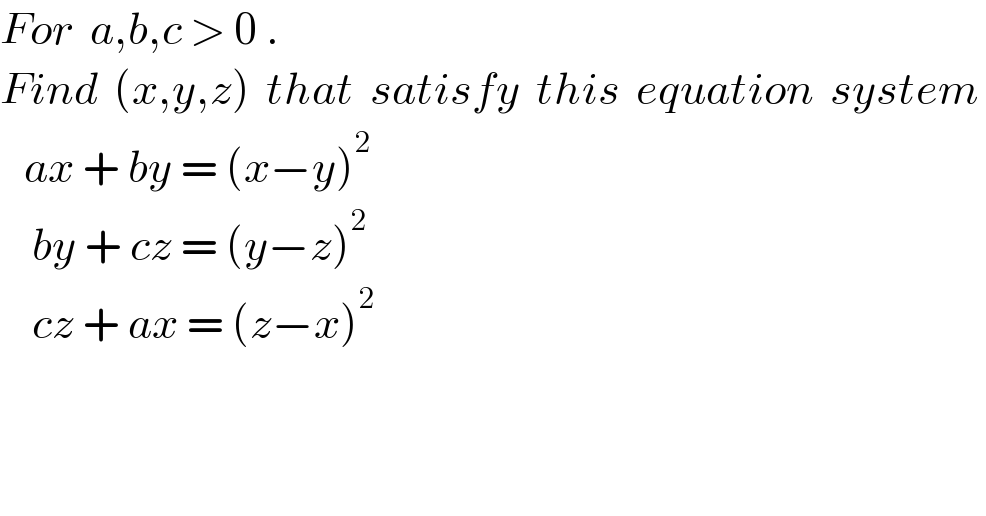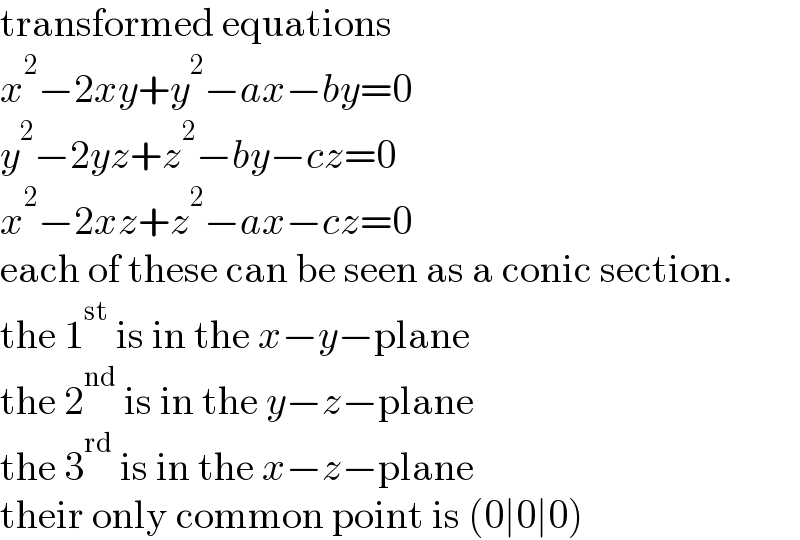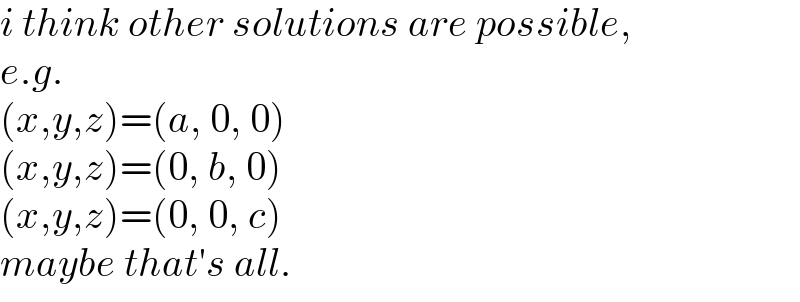
Question Number 161071 by naka3546 last updated on 11/Dec/21

$${For}\:\:{a},{b},{c}\:>\:\mathrm{0}\:. \\ $$ $${Find}\:\:\left({x},{y},{z}\right)\:\:{that}\:\:{satisfy}\:\:{this}\:\:{equation}\:\:{system}\: \\ $$ $$\:\:\:{ax}\:+\:{by}\:=\:\left({x}−{y}\right)^{\mathrm{2}} \\ $$ $$\:\:\:\:{by}\:+\:{cz}\:=\:\left({y}−{z}\right)^{\mathrm{2}} \\ $$ $$\:\:\:\:{cz}\:+\:{ax}\:=\:\left({z}−{x}\right)^{\mathrm{2}} \\ $$ $$ \\ $$
Answered by MJS_new last updated on 11/Dec/21

$$\mathrm{I}\:\mathrm{think}\:\mathrm{the}\:\mathrm{only}\:\mathrm{solution}\:\mathrm{is}\:{x}={y}={z}=\mathrm{0} \\ $$
Commented bynaka3546 last updated on 12/Dec/21

$$\:{How}\:\:{to}\:\:{get}\:\:{it},\:\:{sir}\:? \\ $$ $${Show}\:\:{your}\:\:{workings},\:\:{please}\:. \\ $$ $${Thank}\:\:{you}... \\ $$
Answered by MJS_new last updated on 12/Dec/21

$$\mathrm{transformed}\:\mathrm{equations} \\ $$ $${x}^{\mathrm{2}} −\mathrm{2}{xy}+{y}^{\mathrm{2}} −{ax}−{by}=\mathrm{0} \\ $$ $${y}^{\mathrm{2}} −\mathrm{2}{yz}+{z}^{\mathrm{2}} −{by}−{cz}=\mathrm{0} \\ $$ $${x}^{\mathrm{2}} −\mathrm{2}{xz}+{z}^{\mathrm{2}} −{ax}−{cz}=\mathrm{0} \\ $$ $$\mathrm{each}\:\mathrm{of}\:\mathrm{these}\:\mathrm{can}\:\mathrm{be}\:\mathrm{seen}\:\mathrm{as}\:\mathrm{a}\:\mathrm{conic}\:\mathrm{section}. \\ $$ $$\mathrm{the}\:\mathrm{1}^{\mathrm{st}} \:\mathrm{is}\:\mathrm{in}\:\mathrm{the}\:{x}−{y}−\mathrm{plane} \\ $$ $$\mathrm{the}\:\mathrm{2}^{\mathrm{nd}} \:\mathrm{is}\:\mathrm{in}\:\mathrm{the}\:{y}−{z}−\mathrm{plane} \\ $$ $$\mathrm{the}\:\mathrm{3}^{\mathrm{rd}} \:\mathrm{is}\:\mathrm{in}\:\mathrm{the}\:{x}−{z}−\mathrm{plane} \\ $$ $$\mathrm{their}\:\mathrm{only}\:\mathrm{common}\:\mathrm{point}\:\mathrm{is}\:\left(\mathrm{0}\mid\mathrm{0}\mid\mathrm{0}\right) \\ $$
Commented byMJS_new last updated on 12/Dec/21

$$\mathrm{you}\:\mathrm{are}\:\mathrm{right}.\:\mathrm{pairs}\:\mathrm{of}\:\mathrm{the}\:\mathrm{cones}\:\mathrm{have}\:\mathrm{common} \\ $$ $$\mathrm{points}\:\mathrm{in}\:\mathrm{the}\:\mathrm{axes} \\ $$
Commented bymr W last updated on 12/Dec/21

$${i}\:{think}\:{other}\:{solutions}\:{are}\:{possible}, \\ $$ $${e}.{g}.\: \\ $$ $$\left({x},{y},{z}\right)=\left({a},\:\mathrm{0},\:\mathrm{0}\right) \\ $$ $$\left({x},{y},{z}\right)=\left(\mathrm{0},\:{b},\:\mathrm{0}\right) \\ $$ $$\left({x},{y},{z}\right)=\left(\mathrm{0},\:\mathrm{0},\:{c}\right) \\ $$ $${maybe}\:{that}'{s}\:{all}. \\ $$
Commented bynaka3546 last updated on 13/Dec/21

$${Thank}\:\:{you}\:\:{so}\:\:{much},\:\:{sir}. \\ $$
